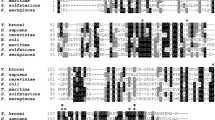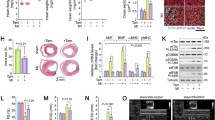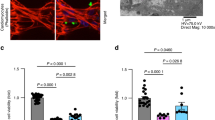Abstract
Inosine triphosphate pyrophosphatase (ITPase), the enzyme that hydrolyzes ITP and other deaminated purine nucleoside triphosphates to the corresponding purine nucleoside monophosphate and pyrophosphate, is encoded by the Itpa gene. In this study, we established Itpa knockout (KO) mice and used them to show that ITPase is required for the normal organization of sarcomeres in the heart. Itpa−/− mice died about 2 weeks after birth with features of growth retardation and cardiac myofiber disarray, similar to the phenotype of the cardiac α-actin KO mouse. Inosine nucleotides were found to accumulate in both the nucleotide pool and RNA of Itpa−/− mice. These data suggest that the role of ITPase in mice is to exclude ITP from the ATP pool, and the main target substrate of this enzyme is rITP. Our data also suggest that cardiomyopathy, which is mainly caused by mutations in sarcomeric protein-encoding genes, is also caused by a defect in maintaining the quality of the ATP pool, which is an essential requirement for sarcomere function.
Similar content being viewed by others
Log in or create a free account to read this content
Gain free access to this article, as well as selected content from this journal and more on nature.com
or
Abbreviations
- ITPase:
-
inosine triphosphate pyrophosphatase
- RBCs:
-
red blood cells
- KO:
-
knockout
References
Lindahl T . Instability and decay of the primary structure of DNA. Nature 1993; 362: 709–715.
Mathews CK . DNA precursor metabolism and genomic stability. FASEB J 2006; 20: 1300–1314.
Taddei F, Hayakawa H, Bouton M, Cirinesi A, Matic I, Sekiguchi M et al Counteraction by MutT protein of transcriptional errors caused by oxidative damage. Science 1997; 278: 128–130.
Maki H, Sekiguchi M . Mut T protein specifically hydrolyses a potent mutagenic substrate for DNA synthesis. Nature 1992; 355: 273–275.
Chung JH, Back JH, Park YI, Han YS . Biochemical characterization of a novel hypoxanthine/xanthine dNTP pyrophosphatase from Methanococcus jannaschii. Nucleic Acids Res 2001; 29: 3099–3107.
Sakumi K, Tominaga Y, Furuichi M, Xu P, Tsuzuki T, Sekiguchi M et al Ogg1 knockout-associated lung tumorigenesis and its suppression by Mth1 gene disruption. Cancer Res 2003; 63: 902–905.
Nakabeppu Y, Sakumi K, Sakamoto K, Tsuchimoto D, Tsuzuki T, Nakatsu Y . Mutagenesis and carcinogenesis caused by the oxidation of nucleic acids. Biol Chem 2006; 387: 373–379.
Mo JY, Maki H, Sekiguchi M . Hydrolytic elimination of a mutagenic nucleotide oxodGTP by human 18-kilodalton protein: sanitization of nucleotide pool. Proc Natl Acad Sci USA 1992; 89: 11021–11025.
Sakumi K, Furuichi M, Tsuzuki T, Kakuma T, Kawabata S, Maki H et al. Cloning and expression of cDNA for a human enzyme that hydrolyzes 8-oxo-dGTP a mutagenic substrate for DNA synthesis. J Biol Chem 1993; 268: 23524–23530.
Rosenquist TA, Zharkov DO, Grollman AP . Cloning and characterization of a mammalian 8-oxoguanine DNA glycosylase. Proc Natl Acad Sci USA 1997; 94: 7429–7434.
Radicella JP, Dherin C, Desmaze C, Fox MS, Boiteux S . Cloning and characterization of hOGG1 a human homolog of the OGG1 gene of Saccharomyces cerevisiae. Proc Natl Acad Sci USA 1997; 94: 8010–8015.
Roldan-Arjona T, Wei YF, Carter KC, Klungland A, Anselmino C, Wang RP et al. Molecular cloning and functional expression of a human cDNA encoding the antimutator enzyme 8-hydroxyguanine-DNA glycosylase. Proc Natl Acad Sci USA 1997; 94: 8016–8020.
Bjoras M, Luna L, Johnsen B, Hoff E, Haug T, Rognes T et al Opposite base-dependent reactions of a human base excision repair enzyme on DNA containing 7,8-dihydro-8-oxoguanine and abasic sites. EMBO J 1997; 16: 6314–6322.
Lu R, Nash HM, Verdine GL . A mammalian DNA repair enzyme that excises oxidatively damaged guanines maps to a locus frequently lost in lung cancer. Curr Biol 1997; 7: 397–407.
Aburatani H, Hippo Y, Ishida T, Takashima R, Matsuba C, Kodama T et al. Cloning and characterization of mammalian 8-hydroxyguanine-specific DNA glycosylase/apurinic, apyrimidinic lyase, a functional mutM homologue. Cancer Res 1997; 57: 2151–2156.
Lin S, McLennan AG, Ying K, Wang Z, Gu S, Jin H et al Cloning, expression, and characterization of a human inosine triphosphate pyrophosphatase encoded by the ITPA gene. J Biol Chem 2001; 276: 18695–18701.
Feng H, Dong L, Klutz AM, Aghaebrahim N, Cao W . Defining amino acid residues involved in DNA-protein interactions and revelation of 3′-exonuclease activity in endonuclease V. Biochemistry 2005; 44: 11486–11495.
Dianov G, Lindahl T . Preferential recognition of I T base-pairs in the initiation of excision-repair by hypoxanthine-DNA glycosylase. Nucleic Acids Res 1991; 19: 3829–3833.
Saparbaev M, Laval J . Excision of hypoxanthine from DNA containing dIMP residues by the Escherichia coli, yeast, rat, and human alkylpurine DNA glycosylases. Proc Natl Acad Sci USA 1994; 91: 5873–5877.
Elder RH, Jansen JG, Weeks RJ, Willington MA, Deans B, Watson AJ et al Alkylpurine-DNA-N-glycosylase knockout mice show increased susceptibility to induction of mutations by methyl methanesulfonate. Mol Cell Biol 1998; 18: 5828–5837.
Cardinal JW, Margison GP, Mynett KJ, Yates AP, Cameron DP, Elder RH . Increased susceptibility to streptozotocin-induced beta-cell apoptosis and delayed autoimmune diabetes in alkylpurine-DNA-N-glycosylase-deficient mice. Mol Cell Biol 2001; 21: 5605–5613.
Chern CJ, MacDonald AB, Morris AJ . Purification and properties of a nucleoside triphosphate pyrophosphohydrolase from red cells of the rabbit. J Biol Chem 1969; 244: 5489–5495.
Behmanesh M, Sakumi K, Tsuchimoto D, Torisu K, Ohnishi-Honda Y, Rancourt DE et al Characterization of the structure and expression of mouse Itpa gene and its related sequences in the mouse genome. DNA Res 2005; 12: 39–51.
Hwang KY, Chung JH, Kim SH, Han YS, Cho Y . Structure-based identification of a novel NTPase from Methanococcus jannaschii. Nat Struct Biol 1999; 6: 691–696.
Tsuzuki T, Sakumi K, Shiraishi A, Kawate H, Igarashi H, Iwakuma T et al Targeted disruption of the DNA repair methyltransferase gene renders mice hypersensitive to alkylating agent. Carcinogenesis 1996; 17: 1215–1220.
Tsuchimoto D, Sakai Y, Sakumi K, Nishioka K, Sasaki M, Fujiwara T et al Human APE2 protein is mostly localized in the nuclei and to some extent in the mitochondria, while nuclear APE2 is partly associated with proliferating cell nuclear antigen. Nucleic Acids Res 2001; 29: 2349–2360.
Fujimoto M, Kuninaka A, Yoshino H . Purification of a nuclease from Penicillium citrinum. Agric Biol Chem 1974; 38: 777–783.
Dutta KK, Nishinaka Y, Masutani H, Akatsuka S, Aung TT, Shirase T et al Two distinct mechanisms for loss of thioredoxin-binding protein-2 in oxidative stress-induced renal carcinogenesis. Lab Invest 2005; 85: 798–807.
Seidman JG, Seidman C . The genetic basis for cardiomyopathy: from mutation identification to mechanistic paradigms. Cell 2001; 104: 557–567.
Towbin JA, Bowles NE . The failing heart. Nature 2002; 415: 227–233.
Kumar A, Crawford K, Close L, Madison M, Lorenz J, Doetschman T et al Rescue of cardiac alpha-actin-deficient mice by enteric smooth muscle gamma-actin. Proc Natl Acad Sci USA 1997; 94: 4406–4411.
Galperin MY, Moroz OV, Wilson KS, Murzin AG . House cleaning, a part of good housekeeping. Mol Microbiol 2006; 59: 5–19.
Burton K, White H, Sleep J . Kinetics of muscle contraction and actomyosin NTP hydrolysis from rabbit using a series of metal-nucleotide substrates. J Physiol 2005; 563: 689–711.
Kornberg A, Baker TA . The building blocks of DNA synthesis In: Kornberg A and Baker TA (eds) DNA Replication (2nd ed.) ( WH Freeman and Company, NY, USA. ) 2002 pp 53–54.
Sumi S, Marinaki AM, Arenas M, Fairbanks L, Shobowale-Bakre M, Rees DC et al Genetic basis of inosine triphosphate pyrophosphohydrolase deficiency. Hum Genet 2002; 111: 360–367.
Maeda T, Sumi S, Ueta A, Ohkubo Y, Ito T, Marinaki AM et al. Genetic basis of inosine triphosphate pyrophosphohydrolase deficiency in the Japanese population. Mol Genet Metab 2005; 85: 271–279.
Acknowledgements
We thank Dr. M Katsuki for CCE ES cells, Dr. Y Nakatsu for discussion, Y Yamada, M Sasaki, M Otsu, S Kitamura and A Matsuyama for technical assistance and Dr. W Campbell for comments on the manuscript. This study was supported by grants from Core Research for Evolutional Science and Technology (to YN), the Japan Science and Technology Agency, the Ministry of Education, Culture, Sports, Science, and Technology of Japan (18012035, 20012038 to KS), and the Japan Society for the Promotion of Science (19651097 to KS and 19390114 to DT).
Author information
Authors and Affiliations
Corresponding author
Additional information
Edited by M Piacentini
Supplementary Information accompanies the paper on Cell Death and Differentiation website (http://www.nature.com/cdd)
Rights and permissions
About this article
Cite this article
Behmanesh, M., Sakumi, K., Abolhassani, N. et al. ITPase-deficient mice show growth retardation and die before weaning. Cell Death Differ 16, 1315–1322 (2009). https://doi.org/10.1038/cdd.2009.53
Received:
Revised:
Accepted:
Published:
Issue date:
DOI: https://doi.org/10.1038/cdd.2009.53
Keywords
This article is cited by
-
An ITPA Enzyme with Improved Substrate Selectivity
The Protein Journal (2024)
-
Novel ITPA variants identified by whole genome sequencing and RNA sequencing
Journal of Human Genetics (2023)
-
Inosine triphosphate pyrophosphatase from Trypanosoma brucei cleanses cytosolic pools from deaminated nucleotides
Scientific Reports (2022)
-
A novel ITPA variant causes epileptic encephalopathy with multiple-organ dysfunction
Journal of Human Genetics (2020)
-
A disease spectrum for ITPA variation: advances in biochemical and clinical research
Journal of Biomedical Science (2016)



